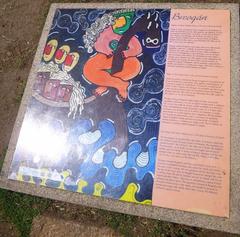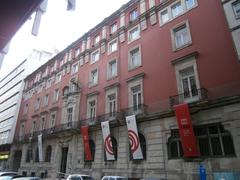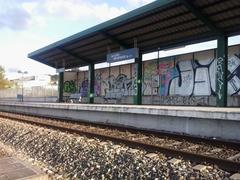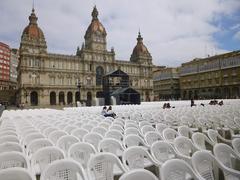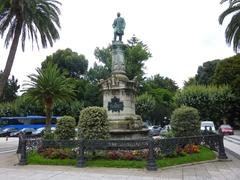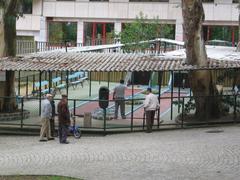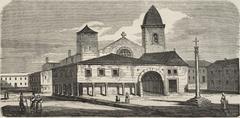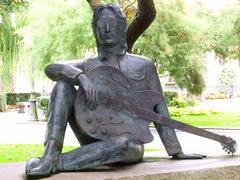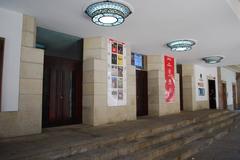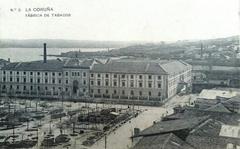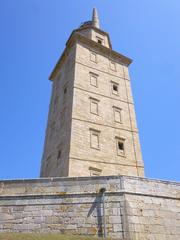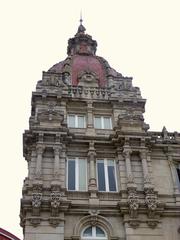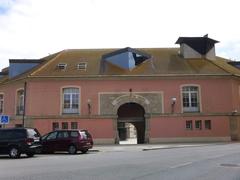Castillo de San Diego: Visiting Hours, Tickets, and Guide to A Coruña Historical Sites
Date: 04/07/2025
Introduction
The Castillo de San Diego once stood as a formidable bastion defending A Coruña’s Atlantic harbor, serving as a crucial node in the city’s coastal defense system alongside the Castillo de San Antón and Castillo de Santa Cruz. Built in the early 17th century atop a tidal peninsula shaped by the Monelos River estuary, the fortress not only protected A Coruña from pirates and foreign fleets but also contributed to the city’s maritime identity. Although demolished in 1963 to accommodate port expansion, the legacy of Castillo de San Diego lives on through local advocacy, historical memory, and ongoing proposals for commemoration and ecological restoration.
This guide delves into the historical and architectural significance of Castillo de San Diego, provides up-to-date visitor information for the site and related landmarks, and offers practical advice for exploring A Coruña’s rich coastal heritage. For further research and updates, consult official resources including La Opinión A Coruña, Ayuntamiento de A Coruña, and La Voz de Galicia.
Contents
- Early Origins and Strategic Purpose
- The Monelos Estuary and Environmental Context
- Evolution, Decline, and Destruction
- Cultural and Historical Significance
- Modern Proposals for Restoration and Commemoration
- Visiting Castillo de San Diego: Practical Information
- Guide to Castillo de San Antón: History, Hours, and Tickets
- Exploring the Area: Tips and Nearby Attractions
- Frequently Asked Questions (FAQ)
- Conclusion and Visitor Summary
Early Origins and Strategic Purpose
Constructed in the early 17th century, the Castillo de San Diego was strategically positioned to defend A Coruña’s port, forming an integrated defense system with the Castillo de San Antón and Castillo de Santa Cruz. Its design reflected the military innovations of its time, with thick stone walls, angular bastions, and advanced artillery positions to deter attacks from sea and land (La Opinión A Coruña).
The Monelos Estuary and Environmental Context
The fortress originally stood atop a tidal peninsula defined by the Monelos River estuary and surrounded by vibrant marshes (xunqueiras). The area’s dynamic ecosystem supported local livelihoods, with tidal mills operating until the late 19th century and women gathering at the riverbanks for washing (La Opinión A Coruña). Over time, port expansion and land reclamation dramatically reshaped the coastline and buried the river’s channel.
Evolution, Decline, and Destruction
A Coruña’s transformation into a modern port city in the 19th and 20th centuries diminished the military relevance of Castillo de San Diego. In 1963, the castle was demolished to facilitate further port development, erasing its physical presence from the landscape (La Voz de Galicia). Today, the former site is part of an industrial port zone, with only street names and local memory hinting at its historical role (La Opinión A Coruña).
Cultural and Historical Significance
Despite its demolition, the Castillo de San Diego remains a potent symbol of A Coruña’s maritime and military history. The fortress, together with the surviving Castillo de San Antón, represents the city’s resilience and strategic importance. Local organizations such as Grupo Naturalista Hábitat and Asociación Veciñal Oza-Gaiteira-Os Castros continue to advocate for recognition and possible reconstruction of the site (La Opinión A Coruña).
Modern Proposals for Restoration and Commemoration
Recent proposals encourage partial removal of port landfill to restore the original estuary and tidal habitats, and even consider reconstructing Castillo de San Diego using modern archaeological methods. These initiatives aim to blend cultural preservation with environmental resilience, potentially creating a new ecological and educational landmark for A Coruña (La Opinión A Coruña).
Visiting Castillo de San Diego: Practical Information
Current Site Status
- No Physical Remains: The castle was demolished in 1963; no ruins or visitor centers remain.
- Access: The location is now integrated into the industrial port. Visitors can view the general area from public roads like Avenida del Ejército, Calle San Diego, and Playa de Oza.
- Visiting Hours/Tickets: As there is no structure, there are no visiting hours or tickets required.
- Safety: Remain within public areas and respect port security signage.
Enhancing Your Visit
- Combine with Other Sites: Visit the nearby Castillo de San Antón and Castillo de Santa Cruz for a more immersive experience of A Coruña’s coastal defenses.
- Historical Resources: Review online historical maps, digital reconstructions, and museum exhibits to better understand the lost fortress (Museo Arqueológico e Histórico de A Coruña; Lucía Sanguinedo Blog).
- Photography: Coastal promenades offer views of the port and city skyline, especially during sunrise and sunset.
Guide to Castillo de San Antón: History, Hours, and Tickets
Historical Overview
The Castillo de San Antón, constructed in the late 16th century on an island at the edge of A Coruña’s port, was a linchpin in the city’s defense network. Notable for repelling the English Armada in 1589, the fortress has since served as a prison, quarantine station, and, today, as the Museo Arqueológico e Histórico de A Coruña (Mundo Estrella Galicia; Ayuntamiento de A Coruña).
Visiting Information
- Location: Easily accessible by foot or public transport from the city center.
- Hours: Typically open Tuesday to Sunday, 10:00 AM–6:00 PM (hours may vary; check official sources).
- Tickets: General admission is approximately €3; discounts are available for students, seniors, and children.
- Accessibility: The museum is wheelchair accessible.
- Guided Tours: Offered in multiple languages on select days.
- Amenities: Panoramic ramparts, exhibition halls, small café, and restrooms available.
Museum Highlights
- Archaeological Collections: Prehistoric, Roman, and medieval artifacts.
- Exhibitions: Rotating displays on military, civic, and maritime history.
- Photographic Opportunities: The ramparts offer stunning views of the bay and city (Spain.info).
Exploring the Area: Tips and Nearby Attractions
Other Historical Sites
- Castillo de Santa Cruz: Accessible across the bay in Oleiros, this castle forms part of the historic defensive system (Castillo de Santa Cruz).
- Playa de Oza: Coastal beach near the former San Diego site, ideal for walks along the maritime landscape.
- Tower of Hercules: The world’s oldest working lighthouse and a UNESCO World Heritage Site.
Visitor Tips
- Transportation: City buses and taxis provide easy access; Estación de San Diego train station is nearby.
- Food & Drink: Cafés and restaurants nearby cater to port workers; for more variety, visit the city center or beach districts.
- Safety: The port area is industrial—stay alert to traffic and remain in pedestrian zones.
Frequently Asked Questions (FAQ)
Q: Can I visit the Castillo de San Diego ruins?
A: No, the castle was demolished in 1963. No ruins or site-specific visitor centers exist.
Q: Are there tickets or visiting hours for the Castillo de San Diego?
A: No tickets or hours apply, as the site is now part of the port and lacks public facilities.
Q: What are the best nearby historical sites?
A: Castillo de San Antón, Castillo de Santa Cruz, and the Tower of Hercules.
Q: Are guided tours available for the Castillo de San Diego?
A: No official tours for the demolished site; some city walking tours include its history as a point of interest.
Q: Is the Castillo de San Antón accessible to visitors with reduced mobility?
A: Yes, the museum is wheelchair accessible.
Conclusion and Visitor Summary
The story of Castillo de San Diego is one of transformation—its physical absence a testament to the evolving needs and ambitions of A Coruña, yet its historical and cultural legacy endures through community memory, advocacy, and heritage initiatives. While the original fortress no longer welcomes visitors, its significance is honored in local museums, commemorative proposals, and the ongoing stewardship of related coastal defenses.
For a deeper experience, complement your exploration of the port area with visits to Castillo de San Antón and Castillo de Santa Cruz, and engage with digital reconstructions and museum exhibits. Stay updated on visiting hours, tickets, and future restoration projects through the Audiala mobile app and official tourism websites. By connecting with these sites, you help preserve and celebrate A Coruña’s remarkable maritime heritage.
References
- “O Castelo de San Diego: Historia, patrimonio e guía para visitantes en A Coruña”, 2024, La Opinión A Coruña (La Opinión A Coruña)
- “Castillo de San Antón: Historia, recorrido y cómo llegar”, 2024, Mundo Estrella Galicia (Mundo Estrella Galicia)
- “Museo Arqueológico e Histórico de A Coruña”, 2024, Ayuntamiento de A Coruña (Ayuntamiento de A Coruña)
- “Castillo de San Diego demolido hace 35 años para ampliar muelles”, 2000, La Voz de Galicia (La Voz de Galicia)
- “Castillo de San Diego Site Visit Guide”, 2009, La Opinión A Coruña (La Opinión A Coruña)
- “Castillo de Santa Cruz”, 2024, Turismo de Oleiros (Castillo de Santa Cruz)
- “History of A Coruña’s Coastal Defenses and Fortifications”, 2024, Spain.info (Spain.info)
- “Castillo de San Diego: Puerto de Oza”, 2019, Lucía Sanguinedo Blog (Lucía Sanguinedo Blog)
- Museo Arqueológico e Histórico de A Coruña


